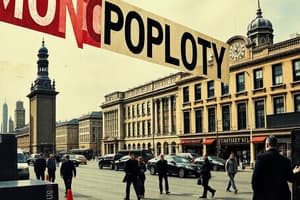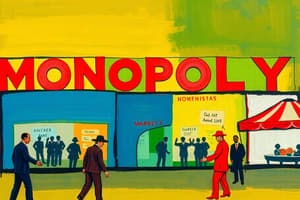Podcast
Questions and Answers
A monopoly is a firm that is the only seller of a product with close substitutes.
A monopoly is a firm that is the only seller of a product with close substitutes.
False (B)
Barriers to entry include monopoly resources, government regulation, and natural monopolies.
Barriers to entry include monopoly resources, government regulation, and natural monopolies.
True (A)
In a natural monopoly, average total cost (ATC) increases as production quantity increases.
In a natural monopoly, average total cost (ATC) increases as production quantity increases.
False (B)
A monopoly is a price taker, similar to firms in perfect competition.
A monopoly is a price taker, similar to firms in perfect competition.
Marginal revenue (MR) in a monopoly is always less than the price (P).
Marginal revenue (MR) in a monopoly is always less than the price (P).
A monopoly maximizes profit by producing the quantity where MR = MC.
A monopoly maximizes profit by producing the quantity where MR = MC.
For a monopoly, price (P) equals marginal cost (MC) in equilibrium.
For a monopoly, price (P) equals marginal cost (MC) in equilibrium.
Monopolies create deadweight loss because they produce a quantity that is lower than the socially efficient quantity.
Monopolies create deadweight loss because they produce a quantity that is lower than the socially efficient quantity.
The inefficiency of a monopoly comes from charging a price higher than the marginal cost, which restricts output.
The inefficiency of a monopoly comes from charging a price higher than the marginal cost, which restricts output.
Price discrimination can increase economic welfare by capturing consumer surplus as producer surplus.
Price discrimination can increase economic welfare by capturing consumer surplus as producer surplus.
Perfect price discrimination is common in the real world.
Perfect price discrimination is common in the real world.
Examples of price discrimination include movie ticket discounts for students and airline pricing based on return dates.
Examples of price discrimination include movie ticket discounts for students and airline pricing based on return dates.
In a competitive market, the price equals both marginal cost and minimum average total cost.
In a competitive market, the price equals both marginal cost and minimum average total cost.
A monopoly does not have a supply curve because price and quantity are jointly determined by demand, MR, and MC.
A monopoly does not have a supply curve because price and quantity are jointly determined by demand, MR, and MC.
Flashcards
Monopoly definition
Monopoly definition
A single seller of a product with no close substitutes.
Barriers to entry
Barriers to entry
Obstacles that prevent new firms from entering a market.
Natural monopoly
Natural monopoly
A monopoly where average total cost falls as production increases.
Monopoly vs. Price Taker
Monopoly vs. Price Taker
Signup and view all the flashcards
Monopoly Marginal Revenue
Monopoly Marginal Revenue
Signup and view all the flashcards
Profit maximization for Monopoly
Profit maximization for Monopoly
Signup and view all the flashcards
Monopoly Price and MC
Monopoly Price and MC
Signup and view all the flashcards
Deadweight loss in monopoly
Deadweight loss in monopoly
Signup and view all the flashcards
Inefficiency in monopoly
Inefficiency in monopoly
Signup and view all the flashcards
Price discrimination
Price discrimination
Signup and view all the flashcards
Perfect price discrimination
Perfect price discrimination
Signup and view all the flashcards
Examples of price discrimination
Examples of price discrimination
Signup and view all the flashcards
Competitive market pricing
Competitive market pricing
Signup and view all the flashcards
Monopoly supply curve
Monopoly supply curve
Signup and view all the flashcards



